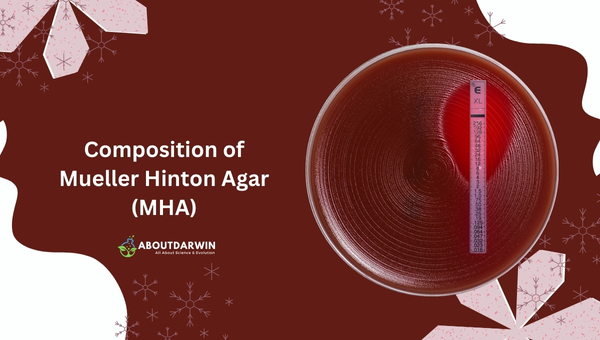Physical Address
304 North Cardinal St.
Dorchester Center, MA 02124
Mueller Hinton Agar (MHA) stands as a cornerstone in microbiology, essential for conducting accurate antibiotic susceptibility tests. This specialized growth medium, composed of beef extract, casein hydrolysate, starch, and agar, creates the perfect environment for bacteria to thrive.
Its simplicity belies its effectiveness, making MHA indispensable in clinical settings where precise pathogen identification is crucial.
As researchers continue to explore the depths of microbial interactions, MHA remains a reliable ally in the fight against antibiotic resistance, showcasing its vital role in modern laboratory practices.
Contents
Mueller Hinton Agar (MHA) is a widely recognized growth medium in microbiology, primarily used for antibiotic susceptibility testing. The MHA agar full form refers to its name, which honors the microbiologists John Howard Mueller and Jane Hinton, who developed this medium in 1941.
Its formulation allows for the growth of various non-fastidious bacteria while providing a reliable environment for assessing their response to antibiotics.
This medium is integral in clinical laboratories for determining effective treatment options against bacterial infections.
These properties make Mueller Hinton Agar an essential medium in clinical microbiology for antibiotic susceptibility testing. Mueller Hinton Agar plays a vital role in microbiological studies and the ongoing fight against antibiotic resistance.
Mueller Hinton Agar (MHA) is a crucial medium in microbiology, particularly for testing bacterial susceptibility to antibiotics.
Its composition is specifically formulated to support the growth of a wide range of bacteria while minimizing factors that could affect the accuracy of antibiotic testing.

The MHA composition is essential for researchers and laboratory technicians to ensure reliable results in antimicrobial susceptibility testing.
The composition of Mueller Hinton Agar includes the following key ingredients:
| Ingredients | g/L |
|---|---|
| Beef Extract | 2.0 |
| Acid Hydrolysate of Casein | 17.5 |
| Starch | 1.5 |
| Agar | 17.0 |
| Final pH | 7.3 ± 0.1 at 25ºC |
The standardized MHA composition ensures that it remains a reliable medium for assessing bacterial susceptibility to various antimicrobial agents, making it an indispensable tool in clinical microbiology laboratories.
Also Read: Identification and Biochemical Testing of Streptococcus pyogenes
Mueller Hinton Agar (MHA) is a fundamental growth medium in microbiology, primarily utilized for antimicrobial susceptibility testing.
Its formulation allows for optimal growth conditions while minimizing interference from substances that could affect the results of susceptibility tests.
The principle of MHA lies in its specific composition, which supports a wide range of bacteria while ensuring accurate testing outcomes.
The principle of MHA is based on its carefully balanced composition, which includes:
This formulation allows for the effective testing of bacterial susceptibility to antibiotics using methods like the Kirby-Bauer disk diffusion test.
In this method, antibiotic-impregnated discs are placed on the agar surface, and the zones of inhibition around each disc are measured to assess the effectiveness of the antibiotics.
The low levels of inhibitors like thymidine and thymine in MHA enhance its reliability for accurate susceptibility testing. Thus, the principle of MHA is crucial for obtaining consistent and reproducible results in microbiological assays.
Knowing that how Mueller Hinton Agar (MHA) functions is essential to grasping its significance in microbial testing. Here’s how the components work together effectively:
When bacteria are swabbed onto an MHA plate impregnated with specific antibiotics—their behavior under these conditions indicates their susceptibility or resistance to each drug.
The inhibition of bacterial growth in the presence of antibiotics denotes sensitivity, while growth despite high antibiotic concentrations warns of potential resistance.
Also Read: Haemolysis in Streptococci: Types and Health Impact
Mueller Hinton Agar (MHA) is a vital growth medium in microbiology, primarily recognized for its role in antibiotic susceptibility testing.
Developed in 1941 by microbiologists John Howard Mueller and Jane Hinton, this medium provides an optimal environment for the growth of various bacteria while ensuring accurate testing results.
Below are the primary uses of Mueller Hinton Agar.
Its unique composition allows for the effective diffusion of antibiotics, making it essential in clinical laboratories for determining bacterial resistance and sensitivity.
Mueller Hinton Agar (MHA) is widely recognized as the standard medium for antibiotic susceptibility testing, particularly using the Kirby-Bauer disk diffusion method.
Its formulation and properties make it ideal for accurately assessing bacterial resistance and sensitivity to various antimicrobial agents.
The choice of MHA is based on several critical factors that ensure reliable and reproducible results in clinical microbiology.
These attributes collectively establish Mueller Hinton Agar as a cornerstone in the field of microbiology for determining the efficacy of antimicrobial agents against bacterial infections.
Also Read: Haemolysis in Streptococci: Types and Health Impact
Mueller Hinton Agar (MHA) is a widely utilized microbiological growth medium primarily employed for antibiotic susceptibility testing, particularly using the Kirby-Bauer disc diffusion method.

This agar provides an optimal environment for the growth of non-fastidious bacteria, making it essential in clinical microbiology for determining the effectiveness of antimicrobial agents.
The preparation of MHA are critical to ensure accurate and reliable results in susceptibility testing. The preparation of MHA involves several key steps to ensure its effectiveness:
Proper preparation and storage are crucial for maintaining the quality of MHA, which directly impacts the accuracy of antimicrobial susceptibility testing.
In any laboratory setting—and especially when preparing culture media like MHA—it’s crucial that safety guidelines are followed diligently at all times:
By keeping these safety measures in mind and following the step-by-step guide above, anyone should be able to prepare Mueller Hinton Agar plates with relative ease and confidence.
Also Read: A Close Look at Mold and Yeast: Deciphering the Differences
Nutrient Agar and Mueller Hinton Agar are both essential culture media used in microbiology, but they serve distinct purposes and have different compositions.
| Feature | Nutrient Agar | Mueller Hinton Agar |
|---|---|---|
| Primary Use | General isolation of bacteria | Antibiotic susceptibility testing |
| Key Components | Beef extract, peptone, agar | Beef infusion, casein hydrolysate, starch, agar |
| Casein Hydrolysate | Absent | Present |
| Sodium Chloride | Present | Absent |
| Solidification Agent | Contains agar | Contains agar |
The difference between Mueller Hinton Agar and Nutrient Agar is crucial for microbiologists, especially when selecting the appropriate medium for specific experiments. Below is a detailed comparison of these two types of agar.
Purpose: Nutrient Agar is primarily used for the general isolation and cultivation of various bacteria and fungi. It provides a nutrient-rich environment suitable for growing non-fibrous organisms.
Composition:
Characteristics:
Purpose: Mueller Hinton Agar (MHA) is specifically designed for antimicrobial susceptibility testing, particularly using the disk diffusion method. This medium is recognized as the standard for these tests.
Composition:
Characteristics:
While Mueller Hinton Agar is specifically tailored for antibiotic susceptibility testing, ensuring accurate results by minimizing interference from other components. Understanding these differences is vital for effective microbiological practices.
Mueller Hinton Agar’s distinctive feature is its optimal combination of starch and beef extract, giving it an ideal consistency and nutrient profile for bacterial growth and antibiotic susceptibility testing.
MHA is crucial in clinical microbiology labs, where it identifies pathogens through cultivating bacteria and fungi and performs antibiotic susceptibility tests.
Common errors made during MHA preparation include inaccurate measurement of ingredients, which can affect the agar’s pH or nutrient content; overheating the mixture, causing it to degrade; or improper sterilization, which may lead to contamination.
If you think your agar medium might be contaminated, immediately discard it following lab safety protocols. Clean your workspace thoroughly before preparing a new batch to prevent cross-contamination.
The correct pH ensures optimal conditions for microbial growth – any fluctuations could change how antibiotics interact with microbes during susceptibility testing.
The effectiveness of MHA agar, specifically Mueller Hinton agar, in microbiological testing is well-established. This medium is essential for determining antibiotic susceptibility and plays a critical role in clinical diagnostics.
Its standardized formulation allows for reliable results, making it a preferred choice in laboratories worldwide.
By facilitating accurate assessments of bacterial resistance, MHA agar contributes significantly to effective treatment strategies and public health initiatives. Emphasizing its importance highlights the ongoing need for precise methodologies in microbiology.